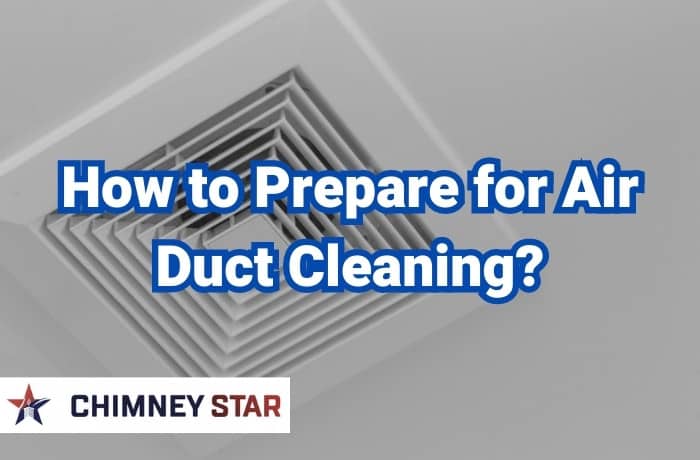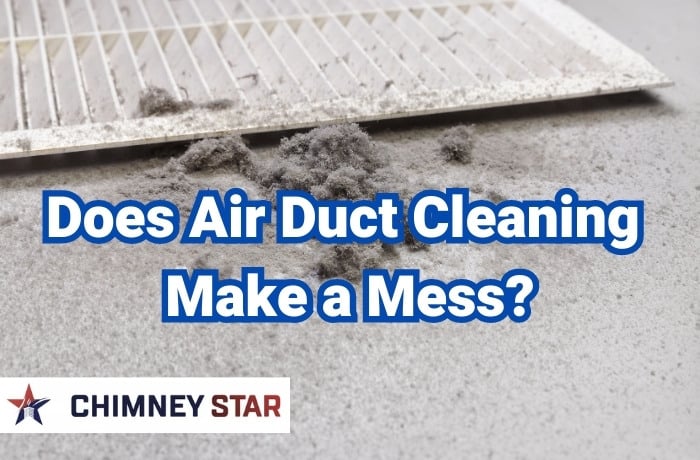Mold in air ducts is primarily caused by excess moisture and poor ventilation, creating the perfect environment for mold to grow and thrive.
In this article, we’ll be discussing the top reasons for mold growth, the symptoms of mold in your air ducts, the risks associated with mold exposure, and effective methods to prevent and remove mold.
Don’t miss out on these vital insights for a healthier home.
The Top 7 Reasons Why Mold Grows in Air Ducts
- Excess Moisture: Moisture is the primary factor that promotes mold growth. High humidity levels, water leaks, or condensation from air conditioning systems can lead to excess moisture in the air ducts, creating an ideal breeding ground for mold.
- Poor Ventilation: Inadequate ventilation can result in trapped moisture and stagnant air, and that too, provides the perfect conditions for mold growth. Proper air circulation is essential for maintaining healthy indoor air quality and preventing mold infestation in the ducts.
- Lack of Maintenance: Neglecting regular maintenance and cleaning of your air ducts can lead to the accumulation of dust, dirt, and debris, which can harbor mold spores. Periodic air duct cleaning can help prevent mold growth and improve your home’s air quality.
- Contaminated Air Filters: Dirty or clogged air filters can contribute to mold growth in air ducts. When filters become saturated with dust and debris, they can trap moisture, leading to mold proliferation. Changing air filters regularly can help keep your air ducts mold-free.
- Insufficient Insulation: If the insulation around your air ducts is insufficient or damaged, it can cause condensation to form on the duct surfaces. This moisture, combined with dirt and dust, creates a fertile environment for mold to grow.
- Leaky Ductwork: Cracks or gaps in your air ducts can allow moisture from outside to enter the ducts, promoting mold growth. Regularly inspecting and sealing any leaks in your ductwork can help prevent mold infestations.
- Water Damage: Water damage due to flooding or plumbing issues can lead to mold growth in air ducts. If your home has experienced water damage, it is essential to have the affected areas thoroughly dried and cleaned to prevent mold from taking hold in your air ducts.
By understanding these common causes of mold growth in air ducts, you can take proactive steps to prevent mold infestation and protect your family’s health.

What are the possible symptoms of mold in your air ducts?
1. Musty or Moldy Odor: One of the most noticeable signs of mold in your air ducts is a persistent musty or moldy smell throughout your home. This odor is particularly noticeable when your HVAC system is running.
2. Visible Mold Growth: If you can see mold growing around your air vents, it’s a strong indication that mold may be present within your air ducts as well. This may appear as black, green, or grayish spots or patches near your vents.
3. Allergic Reactions and Respiratory Issues: Mold exposure can cause or exacerbate allergy symptoms, such as sneezing, itchy eyes, and a runny or stuffy nose. If you or your family members are experiencing increased allergy symptoms or respiratory issues like coughing, wheezing, or shortness of breath, mold in your air ducts could be the culprit.
4. Persistent Headaches: Mold exposure can also cause headaches, especially in sensitive individuals. If you find that your headaches become more frequent or severe when you’re at home, it might be a sign of mold in your air ducts.
5. Fatigue and Dizziness: Prolonged exposure to mold can lead to feelings of fatigue and dizziness. If you notice these symptoms worsening when you spend time at home, it could be an indicator of mold growth in your air ducts.
6. Skin Irritations: Mold exposure can cause skin irritation in some people. If you or your family members develop rashes, hives, or other unexplained skin issues, consider checking your air ducts for mold.
7. Asthma Flare-ups: Excessive mold can even trigger asthma attacks in people with the condition. If you or a family member has asthma and experiences increased frequency or severity of attacks at home, it’s essential to inspect your air ducts for mold.
Remember to consult with a professional if you suspect mold in your air ducts, as they can help identify the issue and provide effective solutions to remove and prevent mold growth.
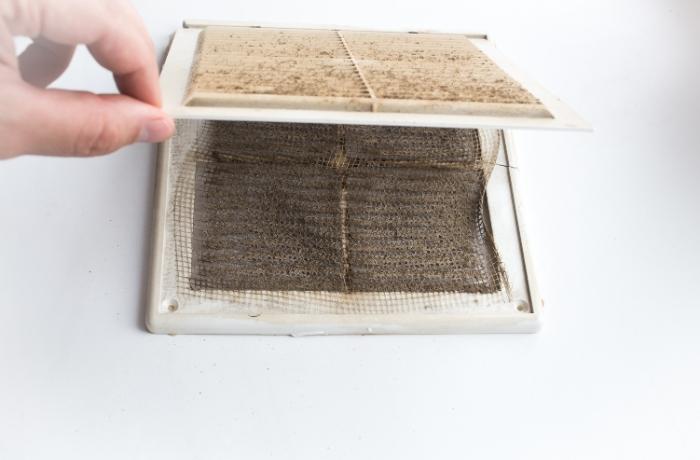
What are the possible risks of having mold in your Air Ducts?
1. Health Risks:
Prolonged exposure to mold can lead to various health issues, particularly affecting the respiratory system. People with allergies, asthma, or weakened immune systems may be more susceptible to the adverse effects of mold. As mentioned, common symptoms include sneezing, coughing, wheezing, shortness of breath, itchy eyes, runny or stuffy nose, skin irritation, headaches, dizziness, and fatigue.
2. Decreased Indoor Air Quality:
Mold growth in air ducts can significantly reduce the indoor air quality of your home. As mold spores circulate through the air, they can cause unpleasant odors, aggravate existing respiratory conditions, and trigger allergy symptoms.
3. Damage to Air Ducts and HVAC System:
Mold can cause damage to the air ducts and HVAC system over time, leading to reduced efficiency, higher energy bills, and costly repairs. Mold can also contribute to the corrosion of metal ductwork and other components within the HVAC system.
4. Spread of Mold Throughout the Home:
If mold is present in your air ducts, it can easily spread to other parts of your home, causing further damage to surfaces, furnishings, and building materials. This can result in expensive remediation efforts and potential health hazards for occupants.
5. Reduced Property Value:
A home infested with mold can suffer a decline in property value, as it poses a potential health risk to potential buyers. Properly addressing and preventing mold growth in your air ducts can help maintain your home’s value and appeal to potential buyers.
To minimize the risks associated with mold in your air ducts, it is crucial to maintain proper ventilation, address moisture issues, and conduct regular air duct cleaning and maintenance. If you suspect mold in your air ducts, it’s essential to consult with a professional for assessment, removal, and prevention of future mold growth.
What is the best way to remove mold from Air Ducts?
The best way to remove mold from air ducts is to hire a professional air duct cleaning service (Like Chimney-Star!) that specializes in mold removal. Professionals have the necessary equipment, expertise, and experience to effectively and safely remove mold from your air ducts. Here’s what you can expect from a professional mold removal process:
- Inspection and Assessment: A professional will first conduct a thorough inspection of your air ducts to determine the extent of the mold problem. They may use specialized equipment, such as a borescope, to visually inspect hard-to-reach areas within the ductwork.


- Containment and Protection: To prevent the spread of mold spores throughout your home during the cleaning process, the professional will seal off the affected areas. They will also use protective gear to ensure their safety during mold removal.
- Cleaning and Mold Removal: The professional will use specialized equipment, such as HEPA vacuums, brushes, and air whips, to remove mold and accumulated debris from your air ducts. They will also use EPA-approved mold-killing agents to clean and sanitize the duct surfaces.
- HVAC System Cleaning: In addition to cleaning the air ducts, the professional will clean and sanitize other components of your HVAC system, such as the air handler, coils, and blower motor, to ensure the entire system is free of mold.
- Air Filter Replacement: It is essential to replace air filters after the mold removal process to prevent mold spores from recirculating through your home. The professional may recommend a high-quality, HEPA-rated air filter to help improve your home’s air quality.
- Post-Cleaning Inspection and Testing: After the mold removal process, the professional will inspect your air ducts and HVAC system to ensure that all traces of mold have been eliminated. They may also perform air quality tests to confirm that the mold issue has been resolved.
- Cleaning up: Professional air duct cleaning companies do their very best to keep your house clean during the cleaning process. However, cleaning air ducts does cause some debris to release into your home, so after the job is done, the company should also clean up your house, leaving it perfectly neat and clean.
DIY Mold Removal from Air Ducts: Is It Possible and Safe?
While it is technically possible to attempt mold removal from air ducts as a DIY project, we do not recommend it. Why? Mold removal can be a complex, time-consuming, and potentially hazardous process. Hiring professionals that specialize in mold removal is the safest and most effective solution. Here are some reasons why DIY mold removal from air ducts may not be the best option:
Health Risks
Mold exposure can lead to various health issues, particularly for those with allergies, asthma, or weakened immune systems. Attempting to remove mold without the proper protective gear and equipment can put your health at risk.
Inadequate Equipment
Professionals use specialized equipment, such as HEPA vacuums, brushes, and air whips, to effectively remove mold and debris from air ducts. Most homeowners do not have access to such equipment, making it difficult to achieve thorough and safe mold removal.
Risk of Spreading Mold Spores
DIY mold removal attempts can inadvertently spread mold spores throughout your home, worsening the problem and potentially causing additional damage. Professionals use containment methods and proper cleaning techniques to prevent the spread of mold during the removal process.
Incomplete Mold Removal
Without the expertise and experience of a professional, it is challenging to ensure that all traces of mold have been removed from your air ducts. Incomplete mold removal can lead to recurring problems and continued health risks.
Potential Damage to HVAC System
Improper cleaning techniques or the use of incorrect equipment can cause damage to your air ducts and HVAC system components, leading to costly repairs or reduced efficiency.
Considering the potential risks and challenges involved in DIY mold removal from air ducts, it is best to rely on a professional air duct cleaning service to ensure the safe and effective elimination of mold from your home.
Effective Strategies to Prevent Mold Growth in Your Air Ducts
Preventing mold growth in your air ducts is essential for maintaining a healthy home environment. By addressing the underlying causes of mold growth and taking proactive measures, you can keep your air ducts mold-free.
Here’s how to do it:
Control Indoor Humidity
Maintain a relative indoor humidity level between 30% and 50% to discourage mold growth. Use dehumidifiers or air conditioners to regulate humidity, and ensure proper ventilation in areas prone to moisture, such as bathrooms and kitchens.
Ensure Proper Ventilation
Good air circulation is crucial for preventing mold growth. Regularly clean and maintain exhaust fans in your bathrooms and kitchen, and make sure your attic and crawl spaces are well-ventilated.
Regular Air Duct Maintenance
Schedule periodic air duct cleaning and maintenance to remove dust, debris, and potential mold spores. A clean and well-maintained duct system is less likely to harbor mold growth.
Change Air Filters Regularly
Replace your HVAC system’s air filters according to the manufacturer’s recommendations or every 3 months. Clean air filters help maintain good air quality and prevent the accumulation of dust and debris, which can contribute to mold growth.
Inspect and Seal Ductwork
Check your air ducts for leaks or gaps, and repair them as necessary. Sealing your ductwork prevents moisture from entering the system and helps maintain proper air circulation.
Address Water Damage Promptly:
If your home experiences water damage due to flooding, leaks, or other issues, promptly dry and clean affected areas to prevent mold growth. If necessary, consult with a professional water damage restoration service to ensure proper remediation.
Insulate Your Ducts:
Properly insulating your air ducts can help prevent condensation and reduce the risk of mold growth. Make sure your ducts are well-insulated, particularly in unconditioned spaces such as attics or crawl spaces.
By implementing these preventive measures, you can effectively reduce the risk of mold growth in your air ducts, ensuring a healthier and more comfortable home environment.
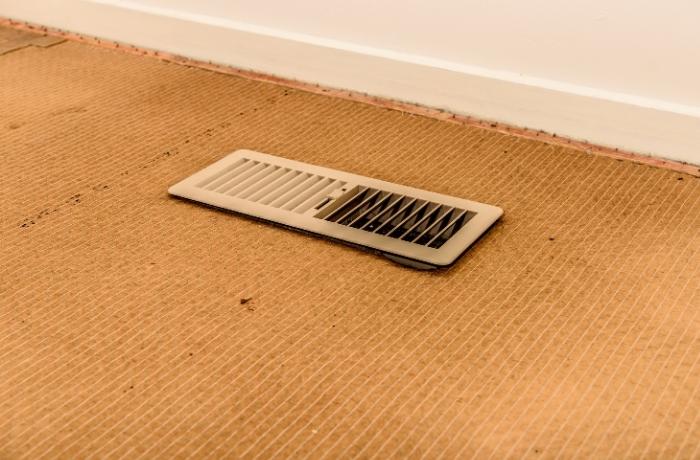
How Often Should You Schedule Air Duct Cleaning for a Mold-Free Home?
To maintain a mold-free home, it is essential to clean your air ducts regularly. While the recommended frequency for air duct cleaning can vary depending on various factors, a general guideline is to have your air ducts professionally cleaned every 3-5 years.
However, certain circumstances may require more frequent cleaning:
- Allergies or Asthma: If you or your family members suffer from allergies or asthma, consider scheduling air duct cleaning more frequently, such as every 2-3 years, to maintain optimal indoor air quality.
- Pets: Homes with pets may experience a higher accumulation of pet dander, hair, and dust in the air ducts. In this case, air duct cleaning every 2-3 years can help maintain a cleaner and healthier environment. If you have pets, you might be interested in reading our blog post on how to prepare for air duct cleaning and how loud is air duct cleaning (& how it affects pets, and what can you do about it).
- Recent Renovations: Construction or renovation projects can introduce a significant amount of dust and debris into your HVAC system. If you’ve recently completed such a project, it’s a good idea to schedule air duct cleaning soon afterward.
- Mold or Moisture Issues: If you’ve experienced mold or moisture issues in your home in the past, it’s essential to monitor your air ducts and schedule cleaning as needed to prevent mold growth.
- Tobacco Smoke: If someone in your household smokes indoors, consider more frequent air duct cleaning to remove tobacco smoke particles and maintain good indoor air quality.
- New Home or New HVAC System: If you’ve recently moved into a new home or installed a new HVAC system, it’s a good idea to have your air ducts cleaned to ensure they are free of dust and debris.
Ultimately, the frequency of air duct cleaning for a mold-free home depends on your specific circumstances and needs. Regularly inspect your air ducts and vents for signs of dust buildup, mold growth, or other issues, and consult with professional air duct cleaners to determine the best cleaning schedule for your home.
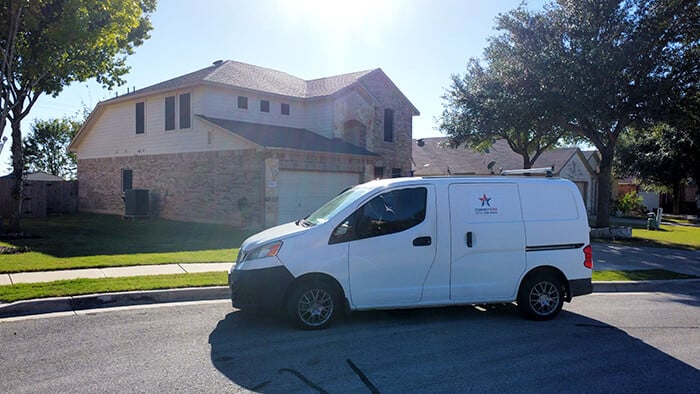
Secure Your Home’s Air Quality and Health with Professional Air Duct Cleaning
Maintaining a mold-free home is crucial for ensuring the health and well-being of your family. By understanding the causes of mold growth in air ducts and taking preventive measures, you can protect your home from potential mold-related risks.
Regular air duct cleaning plays a vital role in maintaining good indoor air quality, preventing mold growth, and keeping your HVAC system running efficiently. So don’t leave your home’s air quality to chance! Trust our professional technicians at Chimney Star to provide thorough and effective air duct cleaning services that keep your home safe & mold-free. Schedule your air duct cleaning today by contacting us and experience the difference a clean and well-maintained HVAC system can make in your home!



